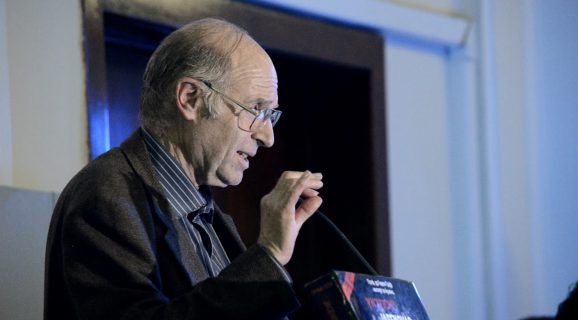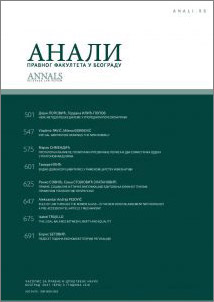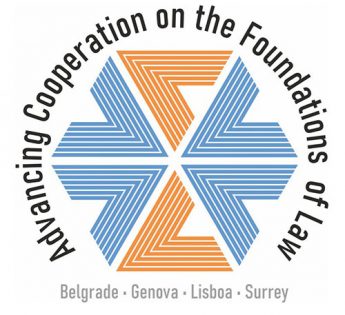
Prof. Dr Gideon Greif Guest at the Panel “National Memory against the Revision of History”
On Thursday, the 9th of December 2021, the University of Belgrade Faculty of Law hosted a panel entitled “National Memory against the Revision of History”. The panel commemorated an extremely important date – on the 9th of December 1948, the Convention on the Prevention and Punishment of the Crime of Genocide was adopted. For six years now the 9th of December has been celebrated as the International Day of Commemoration and Dignity of the Victims of the Crime of Genocide and of the Prevention of this Crime.
On behalf of the Faculty, the panel was opened with a welcome speech by the Vice-Dean for International Cooperation, Prof. Dr Jelena Lepetić, who particularly welcomed the guests of honour, survivors from the Jasenovac and Jastrebarsko concentration camps, among whom were Mr. Gojko Rončević Mraović and Ms. Smilja Tišma, the oldest Member of Parliament and founder of the Association of the Jasenovac Concentration Camp Survivors after World War II. The Vice-Dean for Student Affairs, Aleksa Škundrić, then addressed the attendees on behalf of all the students of the Faculty of Law, pointing out the importance of this panel discussion and the need to keep the memory of these terrible crimes alive. The screening of the short film “Appeal of the Victims of Jasenovac” ensued, followed by the student Luka Milošević reading the text of the SASA initiative for the formation of a Council for National Remembrance, along with a list of members of the last SASA board in charge of collecting information on genocide against the Serbian people and other peoples of Yugoslavia in the 20th century.
The Faculty was honoured to have the renowned Professor, Dr Gideon Greif, as the first speaker at the panel. Prof. Greif has been decorated by the president of Serbia with a gold medal for outstanding services; he is the director of the first two Serbian-Jewish centres, “Saint Sava and Yehuda Alkalai” in Belgrade and Jerusalem, director of the GH7 International Expert Group for Jasenovac and NDH, and the author of a multidisciplinary trilogy on the Jasenovac concentration camp and the Independent State of Croatia: “Jasenovac – Auschwitz of the Balkans, the Ustasha Empire of Cruelty”, “The Ustasha Final Solution before the Nazi Final Solution” and „Alojzije Stepinac, Convert or Die – 101 Reason Why He Cannot be Canonised”. The professor immediately invited the audience to ask their questions, because he saw this panel as an excellent opportunity for open dialogue and discussion. The audience responded with a number of questions on the motivation for writing this lengthy trilogy, the methods that the professor used to separate the facts from lies, the obstacles he met with throughout his research, resemblances and differences between the Ustashas and the Nazis, and the need to protect the thruth from revisionism. Prof. Greif pointed out that the desire for uncovering the truth was the guiding light of his work and that he had never backed down, nor is planning to do so in the future, even though he receives threatening letters on a weekly basis. Historic research is scientific research with precisely defined methods – he follows the facts and what the evidence is telling him, while doing his best to remain objective and not harm anyone with his research. The professor emphasized in particular that his books were the first to compare Auschwitz and Jasenovac, and Nazis and Ustashas on a scientific basis. Unlike the Nazis, who avoided direct contact with their victims, the Ustashas very particularly fond of getting their hands bloody, and the degree of attrocities they commited against the interns of the concentration camps suggests a serious pathology, especially when taking into account the fact that Prof. Greif managed to count 57 different ways the Ustashas used to kill their victims, and that they were the only ones to have children’s concentration camps. Also, they were not only fueled by the thirst for blood, but by greed as well – they often sent people away to concentration camps in order to confiscate their property.
After Prof. Greif, Prof. Dr Boris Begović also addressed the attendees; Prof. Begović is a retired tenured professor of the University of Belgrade Faculty of Law and one of thte editors of the book of proceedings entitled “Legal Order of the Independent State of Croatia” (Pravni poredak Nezavisne države Hrvatske). He spoke of the creation of the proceedings that were the fruit of the scientific conference of the same name, and the hypothesis that was examined on that occasion, which is that the Independent State of Croatia was indeed a state with all the legal attributes. He briefly mentioned the works of his colleagues and professors of the Faculty of Law who examined this hypothesis from their respective disciplines, and the conclusions they reached: most of them agree in their work that the Independent State of Croatia was a true state and that genocide was a state project involving all state structures, with the goal of exterminating the undesirable elements of society. The foundations of this state, however, were not young – they were set by the Croatian political and intelectual elite shortly after World War I, and their legitimacy is confirmed by the attitude of Croatia today, where state leaders and politicians represent the NDH as a result of the age-old desire of the Croatian people for independence, and describe the “for homeland – ready” salute as an old Croatian greeting. In the end, Prof. Begović pointed out that it lies upon the individual to decide what to do with the knowledge they possess, because knowledge is a necessary, but not sufficient requirement to change things and spread the truth.
At the end of the panel discussion, the Ambassador of the Republic of Armenia, H.E. Ashot Hovakimian, addressed the attendees via the Webex platform. The Ambassador spoke of the adoption of the Convention on the Prevention and Punishment of the Crime of Genocide in 1948 and of the notion of genocide within the context of Armenia and the genocide that was committed against the Armenian people. He pointed out that education and remembrance are the most important weapons in the prevention of genocide, but also a tool against the erasure and revision of history.
Artwork that was part of the exhibition “Jasenovac – The Right to Remembrance”, displayed at the UN headquarters in New York, added to the solemnity of the occasion. The artwork on display was the model of the Jasenovac complex, which was six times as large as Auschwitz, and the sculptures created by Katarina Tripković.




